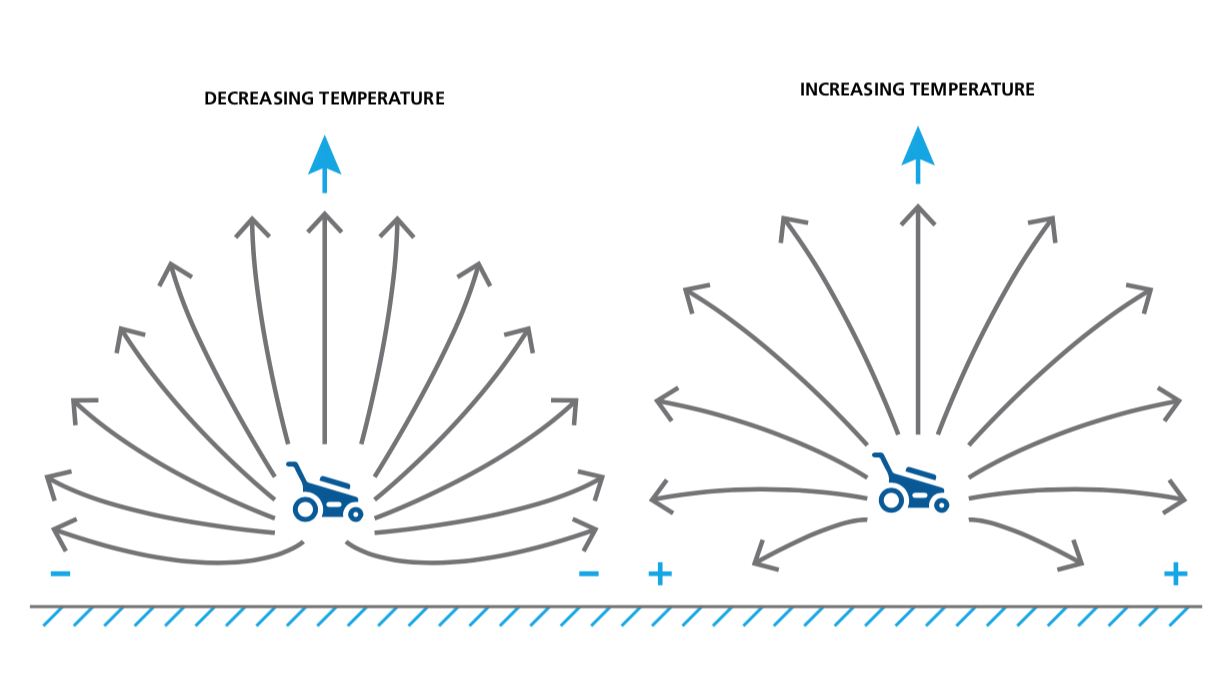 WHITEPAPER
WHITEPAPERFROM SOUND LEVEL METER TO ACOUSTIC CAMERA
A number of meteorological and atmospheric factors, which vary as a function of time, will combine to influence the propagation of sound. Actually, for any given measurement point, the measured result is dependent on weather conditions at the time of the measurement.
Backed by field measurements, this article provides a practical look at the effect of weather conditions on noise levels in order to raise awareness of the importance of meteorology in noise measurements.
Noise Propagation Explained
Noise is essentially a sound wave that, if isotropic, will radiate outwards equally in all directions from the source. Noise levels decrease as the distance increases between the source and the receiver, due to geometric dispersion.
Without any form of atmospheric variation, the sound will decrease by 6 dB per doubling of distance. This law holds true until factors, described below, begin to influence propagation.
Distance from source to the receiver
The most important factor to consider is the distance from the source to the receiver. For many outdoor noise assessments, noise-sensitive receptors are relatively close to the noise source, and in this case, meteorological factors will have a negligible effect.
But how close is close? There is no hard and fast rule, but the ISO 1996-2:2007 standard offers formula and a table to calculate the resulting uncertainty, depending on the heights of the source and receiver and the source-receiver distance.
Wind Speed and Direction When Measuring
Wind speed and direction, even over short periods, are important factors affecting measurements.
Wind blowing from the noise source towards the measurement location increases levels, and the stronger the wind, the greater the effect, until the wind becomes so turbulent that the wind itself becomes the dominant noise source. Therefore legislation sets limits and makes recommendations on acceptable wind speed and direction.
Wind Gradients and Deviating Sound Levels
Wind gradients are caused by friction between the ground and the wind. Thus, wind speed increases with altitude, bending the path of sound to ‘focus’ it on the downwind side, making a ‘shadow’ on the upwind side of the source.
Downwind, the level may increase by a few decibels, depending on wind speed. But when measuring upwind or side-wind, the level can drop by over 20 dB, depending on wind speed and distance This is why downwind measurement is preferred – the deviation is smaller, and the result is a conservative ‘worst case’.
Temperature Gradients and Sound Propagation
 FROM SIMPLE TO ADVANCED
FROM SIMPLE TO ADVANCEDSOUND LEVEL METERS AND VIBRATION METERS
Temperature gradients in the atmosphere also impact sound propagation over long distances. On a typical sunny afternoon, the air is warmest near the ground with temperature decreasing with altitude. This causes sound waves to refract upward, away from the ground, and results in lower noise levels at the listener’s position. In the evening, this temperature gradient will reverse, resulting in cooler temperatures near the ground. This condition often referred to as a temperature inversion, will cause the sound to bend downwards toward the ground and results in louder noise levels at the listener position.
Like wind gradients, temperature gradients can influence sound propagation over long distances.
Effect of temperature gradients: typical day and evening scenarios. Environmental noise, Brüel & Kjær 2001
Atmospheric Attenuation and Frequency
Everyone has heard a concert from a great distance: the high frequencies attenuate and only a muffled bass dominates the remaining sound. Atmospheric attenuation is a physical factor that changes the frequency content of the sound in the air.
The figure below illustrates this effect. In the vast majority of environmental assessments, given the distances and frequencies involved, this factor is negligible.
Attenuation of sound in air as a function of distance and frequency. Environmental noise, Brüel & Kjær 2001
Temperature and Humidity In Sound Measurements
Temperature and humidity affect sound measurements. With a fixed temperature at 15ºC, a decrease in relative humidity from 80% to 20% would decrease the sound level at a listener standing 800 m from the noise source by 3 dB (at 1000 Hz). Although humidity changes slowly, this is a factor that affects measurement repeatability.
Fixing the relative humidity at 80%, an increase in temperature from 15 ºC to 30 ºC would decrease the sound level 800 m from the noise source by 3 dB (at 1000 Hz). Temperature variations of this order of magnitude are not uncommon during a 24-hour period.
National standards may vary in the way the effect of weather should be treated in environmental noise measurements, so refer to your local standards for more information.





